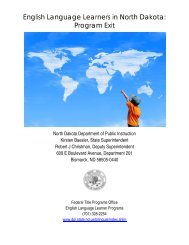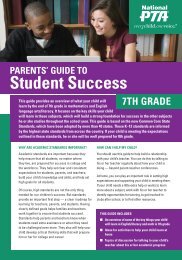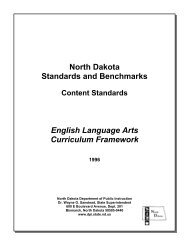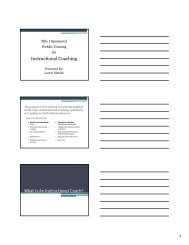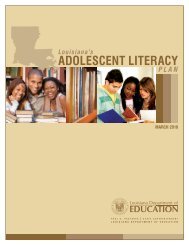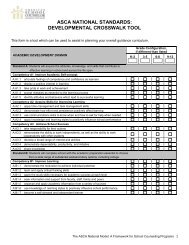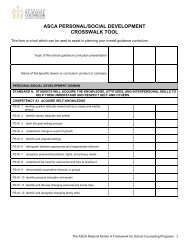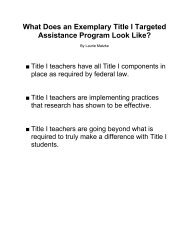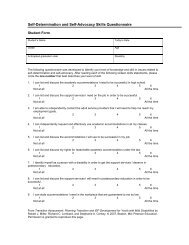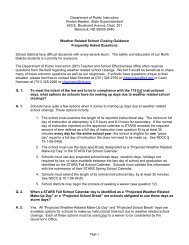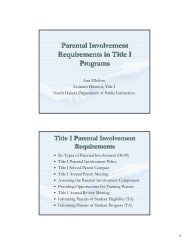Fifteen Effective Strategies for Improving Student Attendance
Fifteen Effective Strategies for Improving Student Attendance
Fifteen Effective Strategies for Improving Student Attendance
You also want an ePaper? Increase the reach of your titles
YUMPU automatically turns print PDFs into web optimized ePapers that Google loves.
Early Childhood Education<br />
General Definition<br />
Birth-to-five interventions demonstrate that providing a child<br />
additional enrichment can enhance brain development. The most<br />
effective way to reduce the number of children who will ultimately<br />
drop out is to provide the best possible classroom instruction from<br />
the beginning of their school experience through the primary grades.<br />
“Early absenteeism is an important predictor of dropping out of<br />
high school” (Epstein & Sheldon, 2002, p. 309).<br />
Publications<br />
Baker, D., & Jansen, J. (2000, January). Using groups to reduce elementary<br />
school absenteeism. Social Work in Education, 22(1),<br />
46-53.<br />
Barnett, W. S. (1995, Fall/Winter). Long-term effects of early childhood<br />
programs on cognitive and school outcomes. The Future of<br />
Children, 5(3), 25-50.<br />
Epstein, J. L., & Sheldon, S. B. (2002). Present and accounted <strong>for</strong>:<br />
<strong>Improving</strong> student attendance through family and community<br />
involvement. The Journal of Educational Research, 95(5), 308-318.<br />
Fashola, O. S., & Slavin, R. (1997). Promising programs <strong>for</strong> elementary<br />
and middle schools: Evidence of effectiveness and<br />
replicability. Journal <strong>for</strong> the Education of <strong>Student</strong>s Placed at Risk,<br />
2(3), 251-307.<br />
Hinkle, D. (2000). School involvement in early childhood. Retrieved<br />
March 6, 2002, from http://www.ed.gov/pubs/schoolinvolvement<br />
Model Programs<br />
HIPPY (Home Instruction Program <strong>for</strong> Preschool Youngsters) is<br />
a home-based, early childhood education program based upon the<br />
premise that parents are the key to their children’s success in school.<br />
HIPPY is designed to enrich the lives of 3-, 4-, and 5-year-old educationally<br />
disadvantaged preschool children over a two-year period.<br />
Parents are trans<strong>for</strong>med into teachers through nontraditional instruction<br />
which uses role-playing as a means to give even those<br />
parents with limited reading skills an opportunity <strong>for</strong> success. The<br />
parent is trained by a paraprofessional from the same community<br />
who also has a child in HIPPY. This paraprofessional visits the home<br />
every other week. Parents are required to work with their children<br />
<strong>for</strong> 15 minutes a day, 5 days a week, 30 weeks a year <strong>for</strong> the 2- to 3year<br />
period. The last year coincides with the child’s kindergarten<br />
year. Material <strong>for</strong> the program is carefully designed to develop language,<br />
visual, auditory, and problem-solving skills. By bringing<br />
storybooks into the home, it makes reading one of the activities<br />
parents and children do together. It provides an opportunity to<br />
strengthen the bonds between parents and children while together<br />
they develop a love of learning. Twice each month parents gather<br />
<strong>for</strong> group meetings where they work with the paraprofessionals to<br />
learn the next week’s activity and have the opportunity to interact<br />
with the other parents. These meetings also provide a <strong>for</strong>um <strong>for</strong><br />
parent enrichment programs. Parents experience personal growth<br />
and become aware of their own strengths. Summative evaluation is<br />
available. Contact: Hippy USA; 220 E. 23rd St., Suite 300; New York,<br />
NY 10010; telephone: 212-532-7730; fax: 212-532-7899.<br />
http://www.hippyusa.org/<br />
10<br />
Truancy Assessment and Service Centers (TASC) provide children<br />
in kindergarten through fifth grade early identification, assessment,<br />
and prompt delivery of coordinated interventions to prevent<br />
continued unexcused absences from school. Children who have five<br />
unexcused absences are referred to the TASC program and screened<br />
<strong>for</strong> treatment. The primary goal of TASC is to mobilize all segments<br />
of the community including schools, mental health, social services,<br />
law en<strong>for</strong>cement, and courts to cooperate in a coordinated and comprehensive<br />
approach to the problems of diverse populations in their<br />
neighborhoods. Since these collaborations have been put in place,<br />
the truancy centers have been empowered to remove barriers to<br />
overall program effectiveness and fill in other identified gaps in services<br />
previously facing at-risk families. Because of the focus on program<br />
integrity and support of community ef<strong>for</strong>ts, 12,054 truant<br />
children were referred to TASC in 2003-04, with 6,340 services provided<br />
to TASC families. At the time of referral in 2003-04, the number<br />
of unexcused absences was 78,669 or an average of nine absences<br />
per student. After TASC involvement, 68% of the children<br />
had fewer than five unexcused absences, while 27% of that same<br />
number had zero unexcused absences after referral. Contact: Leah<br />
Courville, Assistant Director; Louisiana State University School of<br />
Social Work; Office of Social Service Research and Development;<br />
311 Huey P. Long Fieldhouse; Baton Rouge, LA 70803; telephone:<br />
225-578-4950; fax: 225-578-0428. http://www.socialwork.lsu.edu/<br />
ossrd<br />
Web Sites<br />
• The Future of Children has as its primary purpose the dissemination<br />
of timely in<strong>for</strong>mation on major issues related to children’s<br />
well-being. http://www.futureofchildren.org/<br />
• National Association <strong>for</strong> the Education of Young Children (NAEYC)<br />
is the nation’s largest and most influential organization of early<br />
childhood educators and others dedicated to improving the quality<br />
of programs <strong>for</strong> children from birth through third grade.<br />
http://www.naeyc.org<br />
• National Institute on Early Childhood Development and Education<br />
sponsors comprehensive and challenging research in order<br />
to help ensure that America’s young children are successful in<br />
school and beyond—and to enhance their quality of life and<br />
that of their families. http://www.ed.gov/offices/OERI/ECI/<br />
index.html<br />
Early Literacy Development<br />
General Definition<br />
Early interventions to help low-achieving students improve their<br />
reading and writing skills establish the necessary foundation <strong>for</strong><br />
effective learning in all subjects.<br />
“The National Council of Teachers of Mathematics and the Natio<br />
nal Association <strong>for</strong> the Education of Young Children affirm that<br />
high-quality, challenging, and accessible mathematics education <strong>for</strong><br />
3- to 6-year-old children is a vital foundation <strong>for</strong> future mathematics<br />
learning” (National Council of Teachers of Mathematics, 2005).<br />
“Chronic truancy is often the first step on the road to illiteracy,<br />
and all its attendant ills” (American Bar Association, 2001, p. v).<br />
Research Report




